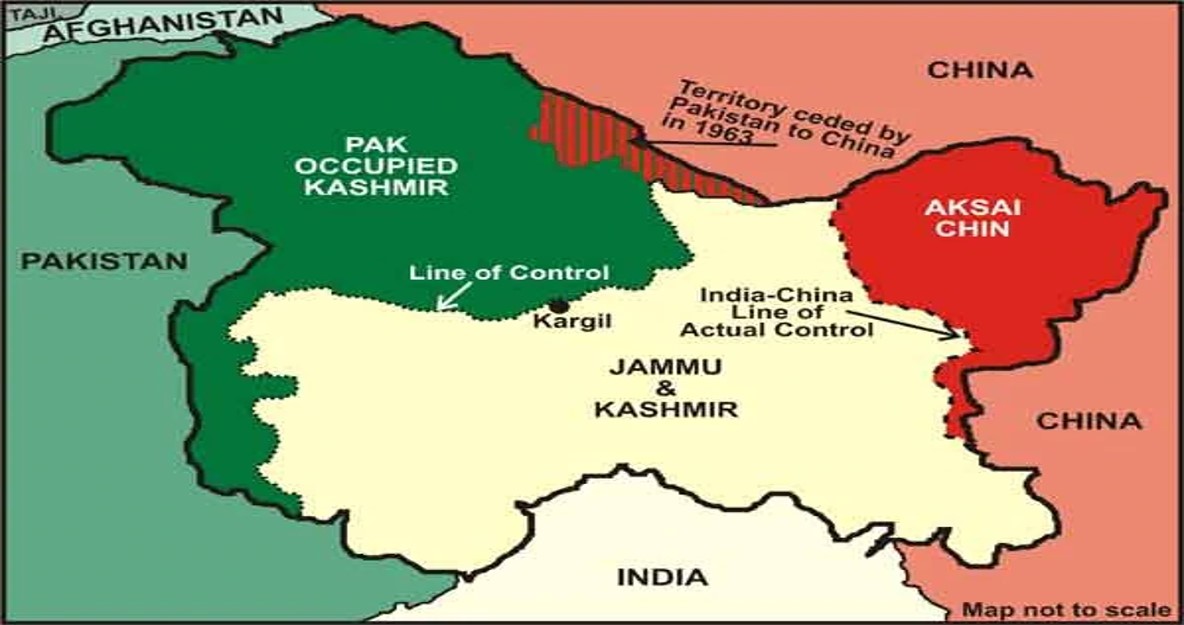Pakistan Occupied Kashmir (PoK) is that part of the Jammu and Kashmir (India) which was invaded by Pakistan in 1947. The region is referred by the United Nations and other international organizations, as ‘Pakistani-controlled Kashmir’ (or Pakistan Administered Kashmir) and it was re-named as ‘Pakistan occupied Jammu-Kashmir’ by the Modi government.
PoK divided into two parts:
Pakistan occupied Kashmir is divided into two parts:
- Azad Jammu and Kashmir (AJK)
- Gilgit-Baltistan (referred to as the ‘Northern Areas’ till August 2009)
Azad Jammu and Kashmir in Pakistan is also called Azad Kashmir and is attached to the western part of Indian Kashmir.
Baltistan was the area of west Ladakh province which was occupied by Pakistan in 1947.
Instrument of Accession
- During partition, Jammu and Kashmir was given the option to join either India or Pakistan but Maharaja Hari Singh, the ruler of that time, decided to keep it as an independent state.
2. In 1947, Pakistan’s Pashtoon tribals attacked Jammu and Kashmir. To tackle this situation, Maharaja Hari Singh sought military help from the then Indian Governor-General Mountbatten.
3. Mountbatten replied saying, “It is my government’s wish that as soon as law and order have been restored in Jammu and Kashmir and her soil cleared of the invader, the question of the State’s accession should be settled by a reference to the people.”
4. Following Mountbatten’s advice, the Indian government attempted a plebiscite, or referendum, for the Kashmiri people to decide if they wanted to stay a part of India, Pakistan, or remain an independent state.
5. The plebiscite could not take place as the Pakistani government and a part of Kashmiri residents questioned the legality of India’s accession to Kashmir, which up till now remains a point of debate.
6. Following this, Maharaja Hari Singh signed the Instrument of Accession at Amar Palace in Jammu on October 26, which India’s last Governor-General Lord Mountbatten accepted on October 27.
7. This remark is said to have sowed the seed of the Kashmir dispute.
Why is PoK important?
Because of its location, PoK is of immense strategic importance. It shares borders with several countries – the Punjab and North-West Frontier Province provinces (now called Khyber-Pakhthunkhwa) in Pakistan to the west, the Wakhan Corridor of Afghanistan in the north-west, Xinjiang province of the People’s Republic of China to the north and India’s Jammu and Kashmir to the east.
Situation of PoK since 1947
After accession, the Indian part of J&K followed the democratic path as per Article 370 of the Indian constitution while the area under Pakistani occupation was bifurcated into two- ‘Azad Jammu and Kashmir’ (AJK) and the ‘Northern Areas,’ which consisted of Gilgit-Baltistan.
AJK is governed under the Azad Kashmir Interim Constitution Act passed in 1974. Even though AJK has a president, prime minister, and a council, the governing structure is powerless and dependent on the Pakistani establishment for the smallest issues. The leaders of AJK surrendered the Northern Areas to Pakistan under the Karachi Agreement of 1949.
The Karachi Agreement, which governs the rule of Pakistan over Gilgit-Baltistan, was signed between the president of Azad Kashmir, the Muslim Conference and a minister without portfolio from Pakistan, Mushtaq Ahmed Gurmani.
9 facts on the history of PoK:
- Jammu and Kashmir remained under the rule of Maharaja Hari Singh and never directly came under the British rule during their colonisation of the Indian subcontinent.
- Though India celebrated its independence on August 15, 1947, Maharajah Hari Singh agreed to accede to the Indian Union only on October 26, 1947.
- Accession Day is a holiday celebrated in Jammu and Kashmir, commemorating October 26, 1947, when Maharaja Hari Singh signed of the Instrument of Accession at Amar Palace in Jammu, to India. The agreement made the former independent princely state of J&K join the Union of India.

- The exact date of accession has also been debated on. While Indian historian Prem Shankar Jha said that the accession document was signed on October 25, British researcher Andrew Whitehead pointed out that it happened a day later.
- Kashmiri separatists observe Accession Day as Black Day.
- Early in the morning on October 27, the Indian Army’s first Sikh battalion was airdropped in Srinagar where they resisted the Pathan invasion and officially completed Kashmir’s accession to India.
- Azad Kashmir claims to have a self-governing legislative assembly though it is a known fact that it is under the control of Pakistan. The present President of the state is Sardar Masood Khan and Raja Muhammad Farooq Haider Khan is its current Prime Minister.
- Pak Occupied Kashmir (POK) also has its own Supreme Court and High Court.
- A part of Pakistan-occupied Kashmir’s Hunza-Gilgit, the Shaksgam Valley, region of Raksam and Baltistan was handed over to China by Pakistan in 1963. This area is called a ceded area or Trans-Karakoram Tract.
The tract, called Shaksgam, is technically part of Shigar, a valley of Baltistan region of Ladakh Province. The Raja of Shigar controlled this land until 1971 when Pakistan abolished the Raja government system.
The Tract is one of the most inhospitable areas of the world, with some of the highest mountains including Broad Peak, Gasherbrum and Masherbrum, and is adjacent to the highest battlefield in the world at Siachen Glacier.

